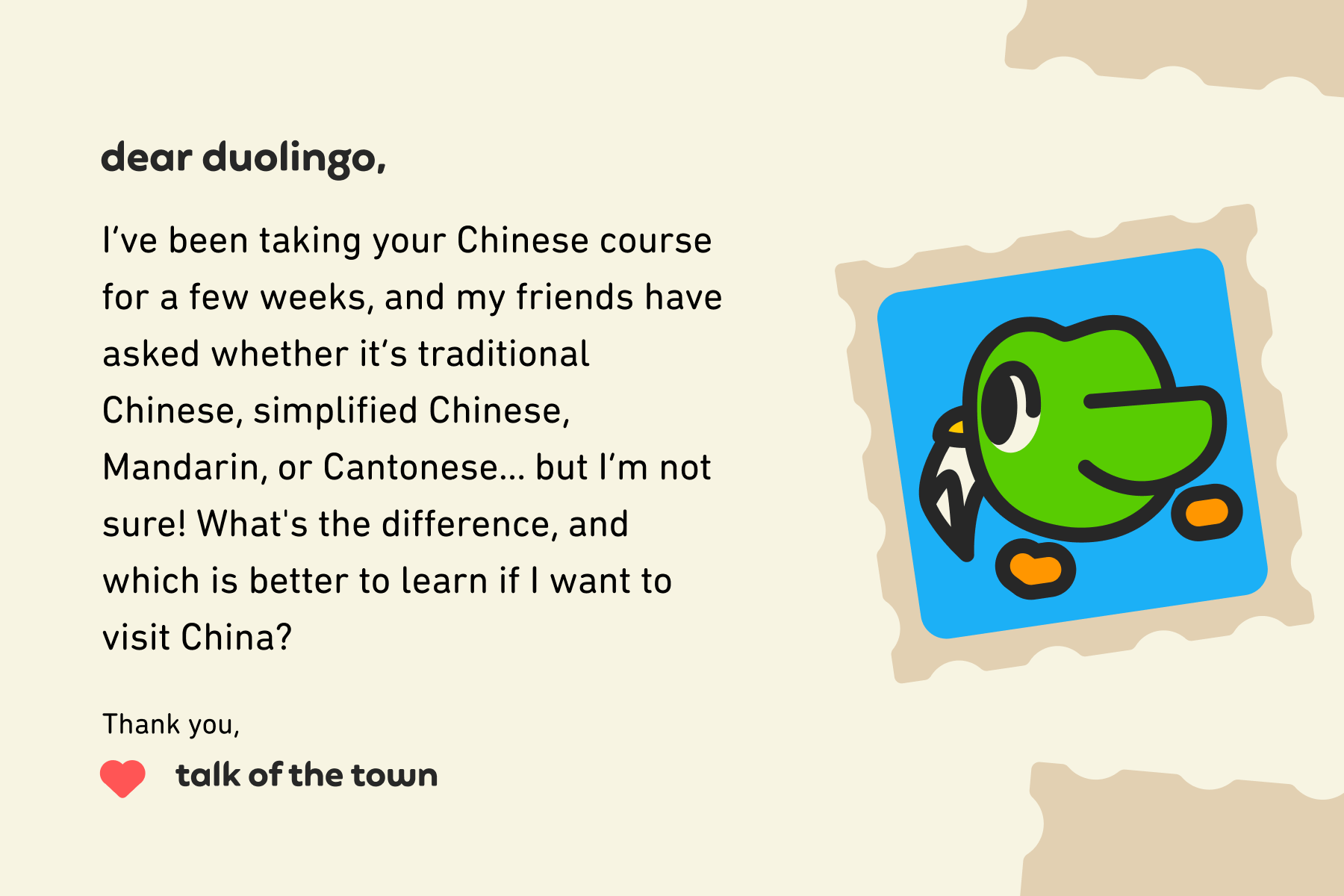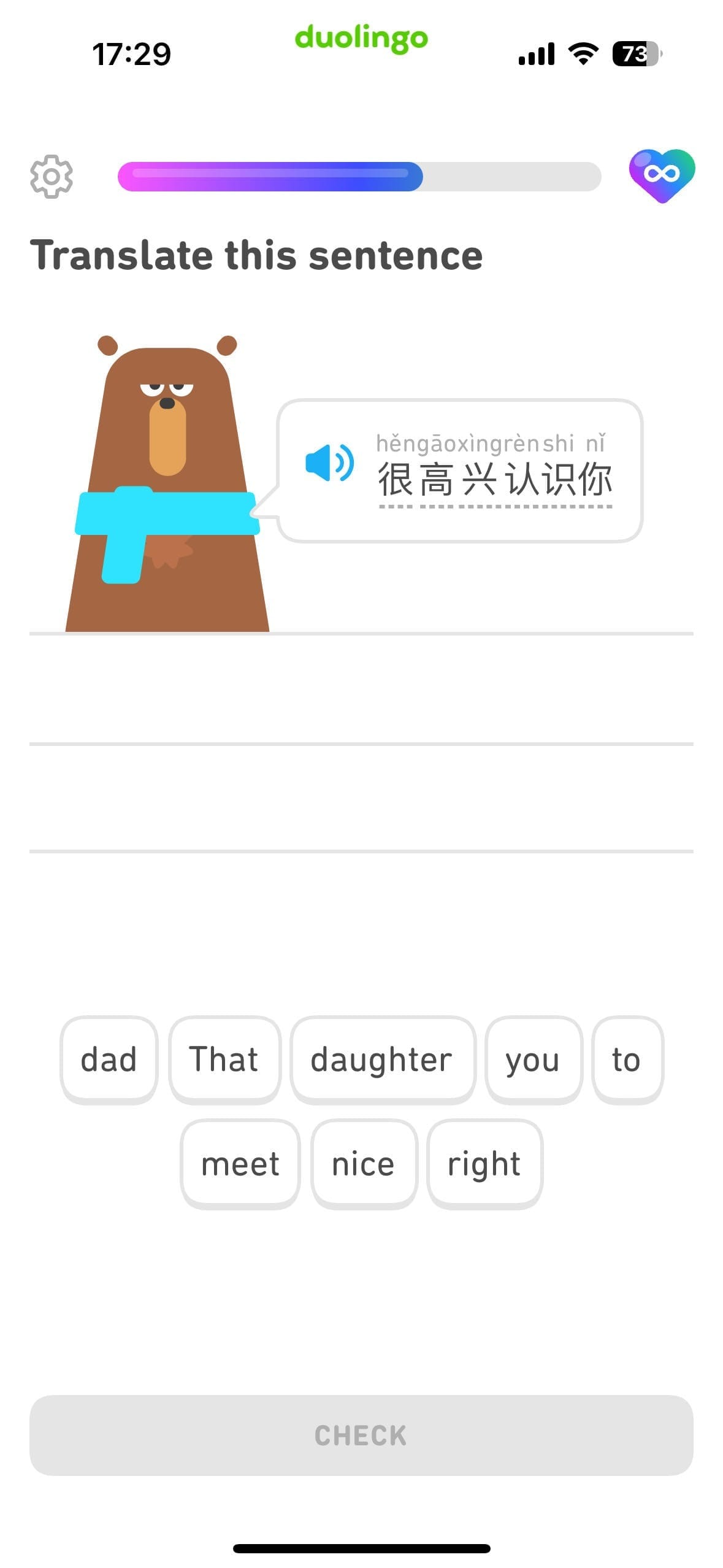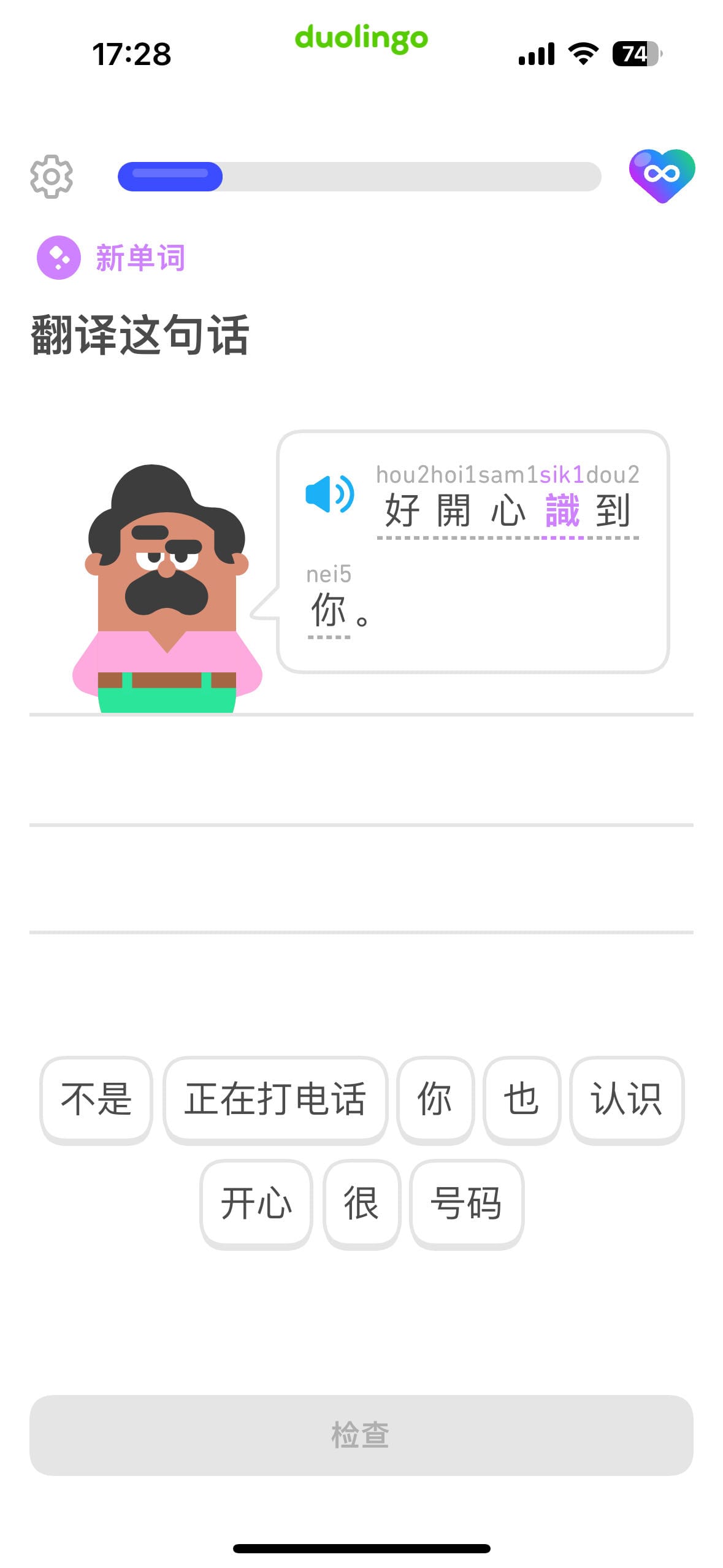Welcome to another week of Dear Duolingo, an advice column just for learners. Catch up on past installments here.
大家好!We’re Tina Tan and Adele Touhey, and we’re taking over Dear Duolingo this week! Tina works on Duolingo’s Chinese course, and Adele focuses on our Korean course, and we're partnering up since there’s something we have in common: We both taught Chinese before joining Duolingo! Our first Dear Duolingo takeover was all about Chinese tones, and this week’s question is again about Chinese—but it’s also about how languages and speakers vary more generally!
Our question this week:

What a good question! Yes, Chinese has a pretty complex system which includes different varieties and different writing systems. Whether or not you’re studying Chinese, you probably already know that Chinese is pretty different from the other languages you know—and there are some interesting complexities about grammar, writing, and spoken Chinese that will impress all learners.
We’re going to give you a brief introduction to Chinese, explain which variety Duolingo teaches, and discuss what you’ll hear and read in China!
What kind of Chinese does Duolingo teach?
Duolingo offers two kinds of courses related to Chinese: courses in Mandarin Chinese with Simplified Characters for English, Japanese, and Vietnamese speakers, and Cantonese in traditional characters for Mandarin speakers.
So, what’s the difference between Mandarin Chinese and Cantonese?
Mandarin, also known as Standard Chinese or Putonghua, is the official language of China. Mandarin is based on the Beijing dialect and is the primary language taught in schools and used in government and media. Mandarin is also the most widely spoken language in China. If you ever travel in China, Mandarin is probably the language you will hear the most! For people interested in learning Chinese, Mandarin is the variety you’re most likely to start with (and the one you’ll find the most resources for).
Cantonese is a major Chinese variety which is primarily spoken in Guangdong province in the south, Hong Kong, and Macau. Cantonese is very different from Mandarin in terms of pronunciation, vocabulary, and even grammar. For example, Mandarin only has four tones, but Cantonese has six! That’s why some people might feel like they are listening to another language when they’re hearing Cantonese 😅
Here’s an example of how we teach “Nice to meet you” in both Mandarin and Cantonese in our App. You can see how different the vocabulary and the pronunciations are. (You’ll see the pronunciations in gray pinyin above the Chinese characters in the speech bubble.)
| Mandarin Chinese | Cantonese |
|---|---|
 |

|
However, Chinese is more than just Mandarin and Cantonese! There are actually even more varieties of the language that are used in China. 👀
Does everyone in China speak the same language?
Yes and no!
In China, almost everyone learns Mandarin in school, so most people can speak Mandarin, at least to some degree. But since China is so big and has many different regions, a lot of people may also speak a regional variety at home, too.
In general, in addition to Cantonese, there are 6 other major groups of varieties spoken in China:
- Northern: spoken across most of northern and southwestern China
- Wu: spoken in the Shanghai region and parts of Jiangsu and Zhejiang provinces
- Gan: predominantly spoken in Jiangxi province
- Xiang: spoken mainly in Hunan province
- Min: primarily spoken in Fujian Province and Taiwan
- Hakka: spoken by the Hakka people in the mountainous regions of southeastern China
The division of Chinese into these seven variety groups is primarily based on linguistic features such as pronunciation, grammar, and vocabulary, along with historical development and geographic distribution. Some of these Chinese varieties are pretty similar to Mandarin and only differ in pronunciation (like the Northern varieties), but others are more different in terms of grammar (like Cantonese and Hakka).
So can someone from Province A understand someone from Province B? The answer is… it depends! If they both speak Mandarin, yes, naturally. If the people speak different varieties, though, then we can think about mutual intelligibility: whether speakers of one variety understand speakers of another, even if they themselves would say something differently. The Northern varieties are mutually intelligible with Mandarin and with each other. For example, a person from Heilongjiang Province in the northeast can easily understand someone from Hebei province near Beijing.
The dialects spoken in the southern part of China are much more different from each other. Even just within the Guangdong province, someone who speaks Cantonese won’t fully understand someone who speaks Hakka.
But, when it comes to reading and writing, things become easier! People from different parts of China can totally understand each other because all varieties share the same writing system: Hanzi.
The writing system of Chinese
Hanzi is the system of characters used to write Chinese—no matter the variety. Unlike alphabets which are “sounded out,” Hanzi is a logographic script, where each character represents a word or a meaningful component of a word. (More on this in a second.)
In Chinese, you can’t tell the pronunciation of a character by simply looking at it. Instead, you learn the meaning of a character, and you memorize the pronunciation separately. There is also a Romanized way to write the pronunciation of characters, called Pinyin. (That’s what was in small gray writing in the screenshots above!)
Since Chinese characters are all about meanings, a lot of characters have a radical. This is a graphical component—part of the overall character—that suggests the general category of the character’s meaning:
| Radical | Meaning of the radical | Characters with the radical |
|---|---|---|
| 女 | female | 妈 (mā, mom) 姐 (jiě, older sister) |
| 讠 | speech | 语 (yǔ, language) 说 (shuō, speak) |
| 氵 | water | 河 (hé, river) 海 (hǎi, sea) |
There are actually two different types of Hanzi scripts: simplified characters and traditional characters. In ancient China, traditional characters were used to write classical Chinese. Then during the 1950s and 1960s, thousands of simplified characters were standardized and adopted in mainland China to promote literacy. Simplified characters are used in mainland China, Singapore, and Malaysia, while Taiwan, Hong Kong, and Macau still use traditional characters.
Here are some examples of traditional-simplified character pairs:
| Simplified Character | Traditional Character | Pinyin | English translation |
|---|---|---|---|
| 爱 | 愛 | ài | love |
| 飞 | 飛 | fēi | fly |
| 声 | 聲 | shēng | sound |
| 语 | 語 | yǔ | language |
Chinese, a linguistically amazing language!
Chinese is interesting linguistically, in part because of its writing system, and also because it has so many different varieties that reflect the deep cultural and historical diversity of its 1.4 billion speakers! So continue learning, decide where you want to travel, and let us know how many varieties you pick up along the way! 加油 (jiāyóu)! Go for it!
For more answers to your Chinese learning questions, get in touch with us by emailing dearduolingo@duolingo.com.
